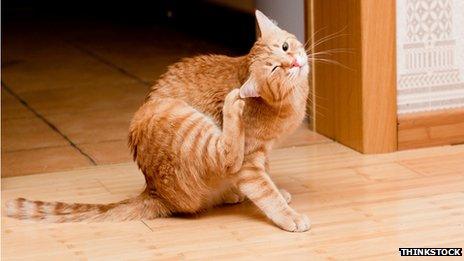Who, What, Why: Have flea numbers jumped?
- Published

Pet owners and those who work with them report a leap in UK flea numbers. If true, what's causing them to spring up?
It's a nuisance that is itching away at British pet owners.
Animal lovers have flooded BBC Radio 4's You and Yours with reports of a surge in the number of insects infesting their pets - many worrying that some kind of "super flea" has built up a resistance to standard treatments.
But experts say warm, wet summers and mild winters are more likely to be behind the jump.
A rise in online shopping may mean consumers are not getting proper advice from vets about how - and how often - to apply flea control.
What is not in doubt is that any such increase is a nuisance not just for Britain's domestic pets but for the owners who have to deal with infestations.
NHS Direct says it has received 8,953 calls complaining of bites and stings in England since early May, compared to 8,641 during the same period last summer and 7,450 in the equivalent time frame from 2010. Not all bite complaints are due to fleas, of course - many can be attributed to bedbugs, midges and mosquitoes.
Lucy Chadwick, head veterinary surgeon with the retailer Pet Drugs Online, says sales of flea treatments are up 25% on previous years.
"The numbers do fluctuate a bit from time to time but this is quite dramatic."
No nationwide survey of the insects' numbers has been published since former RAF pilot and school teacher Bob George, who began mapping them in the 1950s, published his Atlas of the Fleas of Britain and Ireland in 2008. It showed the distribution of the most common varieties including the human flea (Pulex irritans), the dog flea (Ctenocephalides canis) and the cat flea (Ctenocephalides felis).

All that scratching is making me itch
But Dr Tim Nuttall, veterinary dermatologist at the University of Liverpool, says all the anecdotal evidence points to a rise over the past five years - the last two in particular.
"It's almost all related to the cat flea, because the cat flea is quite catholic in its tastes," Nuttall says.
"It will live off cats, it will live off dogs, it will live off ferrets and it will happily live off people."
Key to the increase, he adds, is the weather.
Damp summers and mild winters - coupled with improvements in household insulation which provide warm, humid conditions all year round - allow the flea population to thrive.
Fears have been expressed that the UK is facing an invasion of a new species of uber-flea that has grown impervious to conventional pest control.
But while resistance is an inevitable part of evolution, Nuttall says the problem largely appears to be pet owners not properly applying treatments.
And those buying online or off the shelf are not always getting directions about how to apply treatments, which in the past would have been given by a vet.
Chadwick says it's crucial that all owners receive correct advice at the point of purchase and recommends weighing pets before ordering to determine correct dosages - a process many skip.
Additionally, infestation sites have to be regularly re-treated to prevent a return of the creatures. This is because the life cycle of some fleas can be up to 12 months in unoccupied premises, says Richard Moseley, technical manager of the British Pest Control Association.
"They have an ability to go into a sort of suspended animation," he says. "Even if you go into a flat which has been unoccupied for a year, their cocoons can be set off again by the carbon dioxide in people's breath."
Unless the advice of experts is heeded, fleas are an itch that will increasingly need scratching.
Reporting by Jon Kelly and Simon Browning